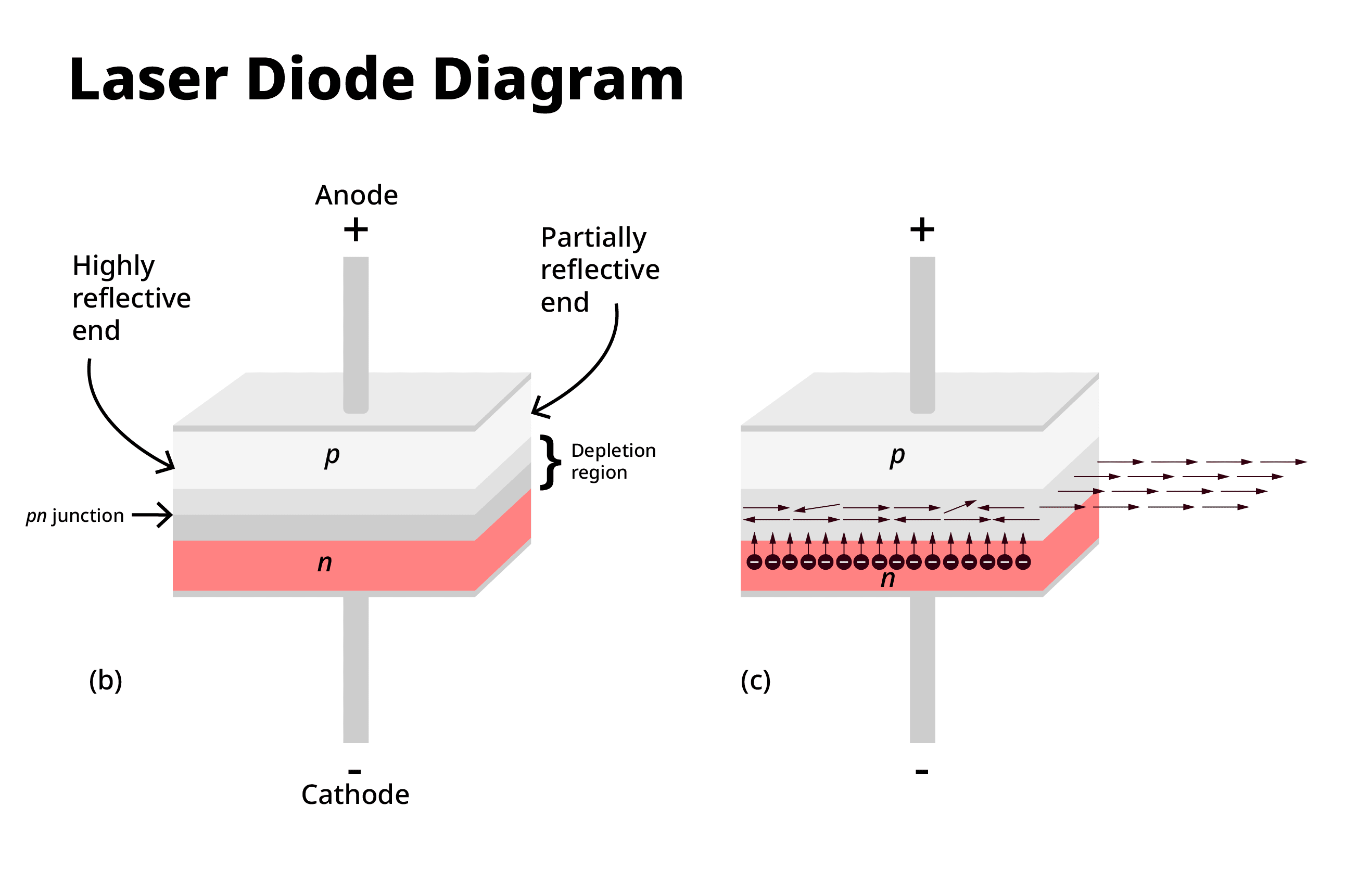- Published 16 Jun 2023
- Last Modified 18 Feb 2025
- 5 min
What is a Laser Diode?
Laser diodes are components that convert and amplify electricity into powerful light. Find out exactly how they work and what their advantages are in this guide.

A laser diode is a device that turns the current passing through an electrical circuit into a strong light beam. Otherwise known as a semiconductor diode laser, their specific construction makes laser diodes a popular choice for circuit builders who need to create a direct light within an electrical circuit.
Available with different wavelength outputs and able to produce infrared light in some cases, these devices offer unique benefits compared to alternatives such as LEDs. This guide will explain exactly what they are and how the construction of laser diodes gives them particular advantages.
How a Laser Diode Works
The specific construction of laser diodes is key to their principle of operation. At the centre of laser diodes is a p-n junction which is a space between a layer of n-type and another layer of p-type semiconductor material. The presence of this means electrical current can only flow in one direction (meaning it's forward-biased).
Typically these materials are gallium arsenide doped with aluminium, silicon, selenium or indium. The p-type layer has more negatively charged particles while the n-type section is filled with electrons.
At the end of these layers are reflective surfaces, with one being completely reflective and the other partially so.
This means when an electrical current is supplied to the laser diode, the following process occurs:
- Free electrons move from the n-type layer to the p-type layer
- Some of these electrons will combine with the negatively charged particles and stimulates them
- This stimulation causes their energy levels to increase and photons (light energy) to be released
- These photons in turn combine with more electrons, causing greater stimulation and further photons to be produced
- This light energy bounces between the two reflective layers, causing a strong beam of light to be released from the laser diode

What is the Difference Between LED and Laser Diode?
Though they’re often placed in the same category as semiconductors, there are key differences between LED and laser diodes that need to be considered by circuit builders, including:
- The high optical gain produced by a laser diode is thanks to the presence of a built-in resonator which prevents light from escaping the device. This means the light beam that’s produced is stronger than through LEDs
- LED light is produced via spontaneous emission which requires no current to be supplied for it to take place. It also produces a lower light output as there’s no extra gain caused by the stimulation of photons as there is in laser diodes
- The light produced by laser diodes is one-directional and coherent in terms of wavelength, unlike that produced by LEDs which can contain various colours
Therefore, if a circuit designer wants to create a strong beam of light efficiently, then a laser diode will be the most appropriate choice. However, if the circuit only requires a low level of light at no specific or regular wavelength, then the LED will be a more economical option.
Types of Laser Diode
The reflective layers at either end of the p-n junction mean that the number of photons released is directly proportional to the number of electrons released and stimulated, with the electrical current flowing through the diode in one direction. The level of energy in every photon produced is also identical.
This means the wavelength of the light produced by a laser diode is consistent (also known as coherent). As such, the colour of the light created by the laser diode is directly related to its wavelength. This is measured in nanometres (nm).
Red Laser Diode
Red laser diodes produce light with a wavelength of 660nm. These are commonly used in levelling devices or handheld pointers.
Blue Laser Diode
Blue laser diodes create light at a 500nm wavelength. This can be easily absorbed by particular materials, making them suitable for particular welding devices and additive manufacturing tools.
Green Laser Diode
Green laser diodes create light at a wavelength of 550nm. This makes them most suitable for printers, surveying tools, and film projectors.
How to Wire a Laser Diode
A laser diode will always have at least three pins. These three pins are defined as input, output, and case (or ground). The anode and the cathode are connected directly to a power supply, usually a battery or DC source, while the case isn’t used.
It’s worth noting that the laser diode symbol is almost identical to that of a semiconductor diode. However, it also includes arrows that show the direction of light emission. This is something to remember when building out your logic diagram before wiring up the circuit.
Although it’s imperative to note that how you wire a laser diode changes depending on the specific type and application, the typical steps (which need to be performed wearing appropriate PPE) include:
- Determine the voltage and current requirements of the laser diode being used. These are typically listed in manufacturer specifications
- Choose a power supply that provides the voltage and current needed by your diode. You may need to use a current-limiting resistor or driver circuit to ensure the current is controlled and doesn't exceed the diode's maximum rating
- Connect the power supply to the laser diode using wires or a PCB. Make sure the polarity is correct and the wires are securely connected. If necessary, add a heatsink or cooling system to prevent the laser diode from overheating
- Test the laser diode using a power meter or oscilloscope to ensure it operates within its specified parameters


